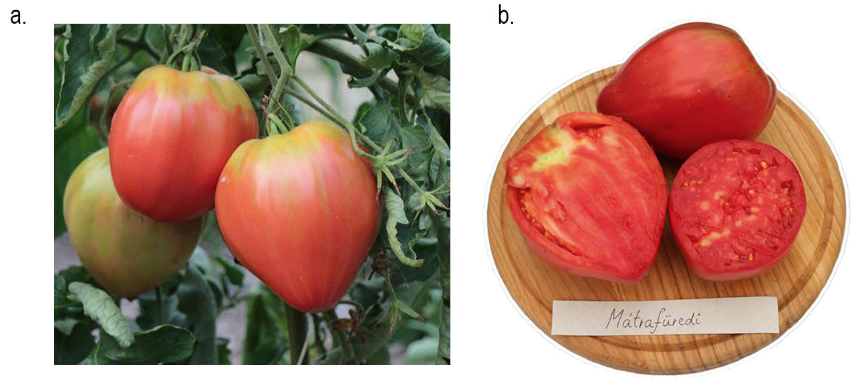Crop: Solanum lycopersicum L. (Tomato)
The landrace called ‘Mátrafüred’ originates from Mátrafüred (Hungary) and it was collected by the Centre for Plant Diversity.
Mátrafüred is an indeterminate, vigorous landrace, growing up to 180-200 cm, with red, ox heart shaped (approx. 110-130 g) fruits, maximum 2-3/cluster. It flowers from June till the first frosts and it ripens from mid-July, with a peak in late August. This landrace is very sensitive to diseases and environmental circumstances, in addition has low productivity. The fruits are very tasty, flavourful, juicy, rich in sugars, making them ideal for fresh consumption and processing. Although the taste is excellent, the transportability, storability and appearance of the fruit is only medium. (Cseperkálóné et al. 2017).
Cultivation System: suitable for low-input conditions, organic cultivation.
Geographical Information
Country: Hungary
Mátrafüred was traditionally cultivated in home gardens of the village Mátrafüred (North-East of Hungary). The National Gene Bank (Centre for Plant Diversity www.nodik.hu) collected and preserved this landrace. The Hungarian Research Institute of Organic Agriculture (ÖMKi) requested accessions from the Centre for Plant Diversity in order to carry out on-farm participatory experiments between 2012-2016, comparing tomato landraces (including Mátrafüred) in five growing seasons in Hungary. In 2018 citizens could ‘adopt’ a seedling choosing from 6 varieties and in 2019 the seedlings of 3 varieties (including Mátrafüred) out of the aforementioned 6 were available in a supermarket.
Nowadays it is cultivated by several farmers and hobby gardeners spread out in the country.
Farmer(s) description:
The farmers, gardeners used to save seeds, which is not a difficult process as this landrace produces a huge amount of seeds and the crop is predominantly autogamous. Seeds are saved from healthy and good performing plants.
Propagation system: Seed, self-pollination
Multiplication procedures and consequences on landrace diversity:Tomato is a predominantly self-pollinating plant, but crosses do occur where presence of insects is high. Each farmer multiplies his own seed under slightly different agronomic conditions. The average number of plants multiplied by each farmer each year ranges from a few to several dozens. At harvesting, each farmer selects seeds that will be used for the next season.
Management plan existence:ND.
Added Values
If there is any market for this landrace, at the moment is very small, it’s mainly grown for own consumption, by hobby gardeners. The landrace is best used for fresh consumption, the storability and processing experiments were giving poor results, therefore there are evidences that this landrace is mainly suitable for home production and for local farmers’ markets.
Others (e.g. commercial/geographical brands or special traits):‘Mátrafüred’ is registered as conservation variety in the European Common Catalogue of Conservation Varieties following the Commission Directive 2008/62/CE of 20 June 2008.
The Hungarian Research Institute of Organic Agriculture (ÖMKi) launched a participatory research on the usability of Hungarian tomato landraces on organic farms in 2012. The aim of the analysis was to reintroduce landraces that were the most suitable for organic production into Hungarian gardens so that their special and diverse colour, shapes and flavours could be rediscovered. In order to make seeds and seedlings available for the wider public, after a precise description ÖMKi registered the most popular and successful 6 landraces in 2019 and support the seedling production in the frame of the campaign ‘From research to plate’.
Accessions of ‘Mátrafüred’ are kept, under long terms storage conditions in the germplasm bank of the Centre for Plant Diversity, Hungary.
The landrace is maintained since 2012 on-farm beyond and as part of the ÖMKi landrace tomato project.
Centre for Plant Diversity www.nodik.hu
Limited number of seedlings are available in the LiDL supermarket since 2019
Seeds available via Magház community seed bank
Case study prepared by The Hungarian Research Institute of Organic Agriculture (ÖMKi), Hungary.
- Cseperkálóné Mirek B., Dr. Drexler D., Papp O. (2017) Paradicsom tájfajták vizsgálata ökológiai gazdálkodásban.
